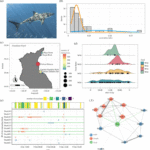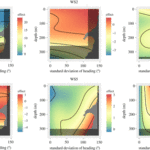Paper, Social dynamics and individual hunting tactics of white sharks revealed by biologging
Social foraging, where animals forage in groups, takes many forms but is less studied in marine predators as measuring social associations in the wild is challenging. We used biologging (activity, cameras and telemetry receivers) sensors to measure social associations and simultaneous behaviour, in white sharks (Carcharodon carcharias) off Guadalupe Island, Mexico. Animal-borne telemetry receivers revealed that sharks varied in the number of associations they formed and occurred most often when sharks were swimming in straight paths or when they were turning frequently. While many associations were likely random, there was evidence of some stronger associations. Sharks varied in the depths they used and their activity, with some individuals more active in shallow water while others were more active 200–300 m deep. We propose that white sharks associate with other individuals so they can inadvertently share information on the location or remains of large prey. However, there may be a wide range of individual variability in both behaviour and sociality. Biologging now enables social associations of animals to be measured, concurrent with measures of their behaviour, so that social foraging of large marine predators can be quantified in the wild.
Learn about our two Decals!
 Click here to find out more about our Fall Bioinspired Design Decal and our Spring Bioinspired Design in Action Decal – ALL MAJORS are welcome.
Click here to find out more about our Fall Bioinspired Design Decal and our Spring Bioinspired Design in Action Decal – ALL MAJORS are welcome.Berkeley BioDesign Community
 Click here to learn about the BioD: Bio-Inspired Design @ Berkeley student organization or here to signup for more info.
Click here to learn about the BioD: Bio-Inspired Design @ Berkeley student organization or here to signup for more info.Search
Student Login





I imagine that the neurological circuits underlying these processes are governed by both 2d spacing maps with their brains as…
to reduce the impact of car accidents, it may be possible to study the force diverting physics of cockroaches to…
you see this type of head-bobbing stability in many avian creatures related to pigeons like chickens. the head ability to…
not like they taught horses how to run! this is an example of convergent evolution where both sea creatures and…
The brain functions in a similar way with neuronal connections. our brains are able to utilize the multiplicity of connections…